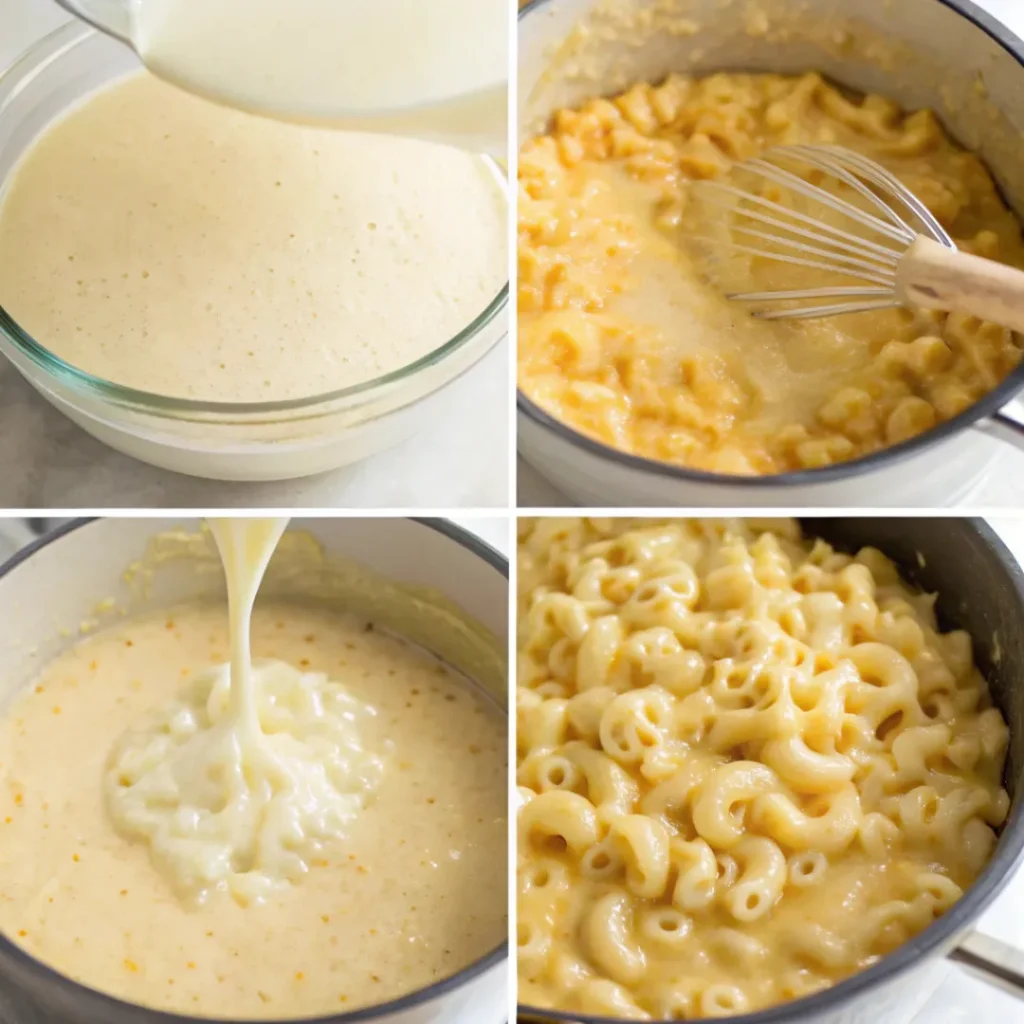Macaroni and cheese is a beloved comfort food, and everyone has their favorite way of making it. While there are countless variations, one ingredient that often surprises people is evaporated milk. You may be wondering: Why use evaporated milk in mac and cheese? The answer lies in its unique qualities that make the dish creamier, richer, and more stable.
In this article, we’ll explore the reasons evaporated milk is a fantastic choice for mac and cheese, how it compares to other milk options, tips for incorporating it into your recipe, and even a delicious mac and cheese recipe featuring evaporated milk. Whether you’re new to using evaporated milk or looking to enhance your recipe, this guide will show you why it’s a pantry staple for many mac and cheese lovers.
What is Evaporated Milk?

Evaporated milk is a concentrated milk product created by heating milk to remove about 60% of its water content. This process gives evaporated milk a thicker, creamier consistency than regular milk, making it a popular choice in both savory and sweet recipes. Evaporated milk is sold in cans and does not need to be refrigerated until it is opened, making it a convenient pantry item.
In addition to its convenience, evaporated milk has a richer, slightly caramelized flavor due to the cooking process, which enhances the taste of many dishes, especially creamy ones like mac and cheese.
Why Use Evaporated Milk in Mac and Cheese?
Evaporated milk is a fantastic addition to mac and cheese because it provides a creamy, stable base for the cheese sauce. Traditional milk can sometimes lead to a runny or separated sauce, but evaporated milk creates a smooth, thick consistency that holds up well in baked dishes. Here are some of the main reasons to use evaporated milk in mac and cheese:
Creamy Texture
The reduced water content in evaporated milk creates a thicker, creamier sauce.
Enhanced Flavor
The gentle caramelization during the evaporation process adds a subtle depth of flavor.
Stability
Evaporated milk helps prevent the sauce from separating, especially when baking mac and cheese.
Convenience
Evaporated milk is shelf-stable and easy to store, making it convenient for spontaneous cooking.
These qualities make it an ideal choice for those looking to make a rich, delicious mac and cheese that won’t compromise on texture.
The Benefits of Evaporated Milk for Texture and Flavor
Evaporated milk has several benefits that contribute to the ideal mac and cheese texture and flavor:
Smooth and Velvety Texture
Its thick consistency makes the sauce smooth and velvety, perfect for coating the pasta evenly.
Richer Flavor Profile
The slight caramelization from the evaporation process adds a hint of richness and depth that regular milk doesn’t provide.
Less Likely to Curdle
Evaporated milk is less likely to curdle or separate, even when exposed to high heat, which is especially helpful for baked mac and cheese recipes.
For more on how evaporated milk creates a velvety mac and cheese, check out this guide from The Daily Meal.
How Evaporated Milk Compares to Other Milks
When it comes to choosing milk for mac and cheese, there are several options, each with its own characteristics:
Whole Milk
Adds creaminess but is less thick than evaporated milk. It may lead to a slightly runny sauce if not thickened properly.
Half-and-Half
Thicker than whole milk but not as concentrated as evaporated milk. It’s a good option but can be heavier.
Heavy Cream
Provides a very rich sauce but can make the dish overly heavy and calorie-dense.
Plant-Based Milks
Almond or soy milk can work in mac and cheese, but they lack the creaminess of dairy and may need thickening agents.
Evaporated milk strikes a good balance, providing thickness without the heaviness of cream and a more stable texture than whole milk.
Tips for Using Evaporated Milk in Mac and Cheese
Using evaporated milk in mac and cheese is straightforward, but here are some tips to help you get the best results:
Add Gradually
When making the sauce, add evaporated milk gradually to ensure it blends smoothly with the cheese.
Combine with Regular Milk
For a lighter texture, you can mix evaporated milk with a bit of regular milk.
Use a Thickener
If you prefer a thicker sauce, whisk in a bit of flour with the butter before adding evaporated milk to create a roux.
Avoid Boiling
Gently heat the evaporated milk to avoid burning or curdling.
These tips will help you create a perfectly smooth and creamy sauce with evaporated milk.
How to Substitute Evaporated Milk in Recipes
If you don’t have evaporated milk on hand, there are ways to substitute it in mac and cheese:
Whole Milk + Cream
Use a mix of whole milk and a bit of heavy cream to replicate the thickness of evaporated milk.
Milk Powder
Reconstitute milk powder to make a thicker milk that can mimic evaporated milk.
Simmered Regular Milk
Simmer regular milk until it reduces by about 60% to achieve a similar consistency.
These substitutions can work in a pinch, though they may lack the slight caramelization of evaporated milk.
Classic Mac and Cheese Recipe with Evaporated Milk
Here’s a simple, classic recipe that showcases the benefits of evaporated milk in mac and cheese:

Ingredients
- 2 cups elbow macaroni
- 3 tablespoons unsalted butter
- 3 tablespoons all-purpose flour
- 1 can (12 oz) evaporated milk
- 1 cup whole milk
- 3 cups shredded sharp cheddar cheese
- Salt and pepper to taste
- 1/2 teaspoon mustard powder (optional)
- 1/4 teaspoon paprika (for garnish)
Instructions
- Cook the Macaroni: Boil the macaroni in salted water until al dente. Drain and set aside.
- Make the Roux: In a large saucepan, melt butter over medium heat. Add flour and whisk continuously for about 1 minute until smooth.
- Add the Milk: Gradually pour in the evaporated milk and whole milk, whisking continuously until smooth and thickened, about 5 minutes.
- Add the Cheese: Lower the heat and stir in shredded cheddar cheese until melted and creamy. Add salt, pepper, and mustard powder to taste.
- Combine with Pasta: Add the cooked macaroni to the cheese sauce, stirring to coat evenly.
- Serve and Garnish: Serve warm, garnished with a sprinkle of paprika.
This recipe provides a rich, creamy mac and cheese with a velvety sauce thanks to the evaporated milk.
Variations for Different Flavor Profiles
You can customize your mac and cheese with evaporated milk by adding different ingredients:
Spicy Mac and Cheese
Add a pinch of cayenne pepper or diced jalapeños for a spicy kick.
Herb-Infused
Stir in fresh herbs like thyme or rosemary for a fragrant twist.
Three-Cheese Blend
Use a combination of sharp cheddar, mozzarella, and Gruyère for complex flavor.
These variations allow you to personalize your mac and cheese while keeping it creamy and delicious.
Common Mistakes to Avoid with Evaporated Milk
To ensure your mac and cheese turns out perfect, avoid these common mistakes:
Using Evaporated Milk Cold
Let it come to room temperature before adding to the roux to avoid lumps.
Overheating the Sauce
Heat gently to prevent curdling or separation.
Not Using Enough Cheese
Evaporated milk can handle a lot of cheese, so don’t skimp if you want a rich sauce.
Avoiding these mistakes will result in a smooth, creamy mac and cheese every time.
Health Benefits of Using Evaporated Milk
Evaporated milk has some nutritional benefits compared to heavy cream and other thickening agents:
Lower in Fat
Evaporated milk contains less fat than cream, making it a lighter option.
Calcium-Rich
Evaporated milk is high in calcium, supporting bone health.
Protein Source
With 7 grams of protein per cup, evaporated milk adds protein to your mac and cheese.
These benefits make it a balanced choice that doesn’t compromise flavor.

How to Store and Use Leftover Evaporated Milk
If you have leftover evaporated milk, here’s how to store it:
Refrigerate
Store unused evaporated milk in an airtight container in the fridge for up to 5 days.
Freeze
Freeze in ice cube trays for easy portioning, then transfer to a freezer bag.
Use in Other Recipes
Evaporated milk is great in soups, sauces, and even coffee.
Storing leftovers properly ensures you can use evaporated milk in multiple recipes.
Frequently Asked Questions
Can I use evaporated milk instead of regular milk in mac and cheese?
Yes, evaporated milk works well as a substitute and creates a creamier sauce than regular milk.
Does evaporated milk make mac and cheese thicker?
Yes, evaporated milk has a thicker consistency, helping create a velvety, rich sauce.
Can I mix evaporated milk with other types of milk?
Absolutely! Combining evaporated milk with regular milk can create a lighter but still creamy texture.
What’s the difference between evaporated milk and condensed milk?
Evaporated milk is unsweetened, while condensed milk is sweetened and not suitable for savory dishes like mac and cheese.
Conclusion
Using evaporated milk in mac and cheese elevates this classic comfort food, adding a smooth, creamy texture and a slightly richer flavor without the heaviness of cream. With its stability, convenience, and ability to resist curdling, evaporated milk is a fantastic choice for mac and cheese lovers seeking the perfect balance between creamy and rich. Whether you’re making a simple stovetop version or baking it in the oven, evaporated milk can help you create a mac and cheese dish that’s just as delicious as it is comforting.
Try incorporating evaporated milk into your next mac and cheese recipe and see how it enhances the texture and taste of this family favorite.

